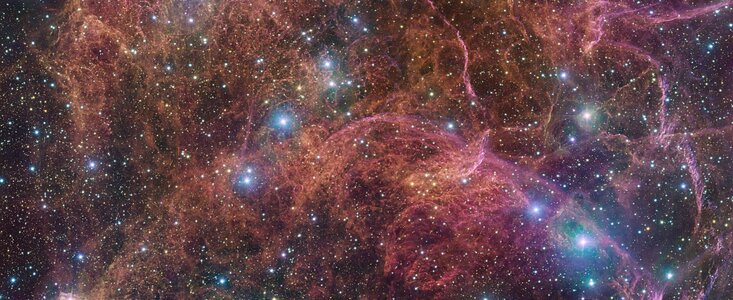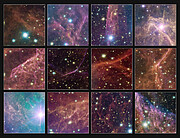Pressmeddelande
ESO fångar de spöklika resterna av en massiv stjärna
31 oktober 2022, Skurup
Ett gyttrigt spindelnät, magiska drakar eller spår efter vandrande spöken? Vad ser du i denna bild av supernovaresten i Seglet? Dessa efemära färger och former är resterna av en enorm stjärna, fångade i utsökta detaljrikedom med VLT Survey telescope vid Europeiska sydobservatoriet (ESO) i Chile.
De rosa och orangea filamenten är allt som finns kvar av en en massiv stjärna som slutade sitt liv i en energirik explosion för 11 000 år sedan. När de mest massiva stjärnorna når slutet av sina liv sker det ofta med en smäll, en så kallad supernova. Dessa explosioner orsakar chockvågor som rör sig genom den omgivande gasen, komprimerar den och formar intrikata trådlika strukturer. Energin från chockvågen värmer upp gasfilamenten och får dem att lysa, som här.
Denna bild med sina 554 miljoner pixlar förevigar en extremt detaljrik vy av supernovaresten i den sydliga stjärnbilden Seglet. Himmelsytan är lika stor som nio fullmånar, men hela supernovaresten är betydligt större än så. På ett avstånd av endast 800 ljusår är detta en av de närmaste kända objekten av detta slag.
Vid explosionen kastades stjärnans yttre atmosfärslager ut i gasen i den omgivande rymden. Det som återstår av stjärnan är en extremt kompakt kärna av protoner och elektroner som har pressats samman till neutroner – en neutronstjärna. Neutronstjärnan i denna supernovarest ligger strax utanför bildens övre vänstra hörn och är en pulsar, en neutronstjärna som roterar kring sin egen axel mer än tio gånger per sekund.
Bilden är en mosaik av observationer gjorda med vidvinkelkameran OmegaCAM på VLT Survey Telescope (VST) vid ESO:s Paranalobservatorium i Chile. Kameran har 268 miljoner pixlar och kan ta bilder genom flera olika filter för att detektera varierande färger och ämnen. För denna bild användes fyra filter som kombinerades i fyra färglager: magenta, blå, grön och röd.
VST ägs av The National Institute for Astrophysics (INAF) i Italien och är med sin 2,6 meter stora spegel ett av de största teleskopen dedikerade för himmelskartläggning i synligt ljus. BIlden ingår i kartläggningsprojektet VPHAS+ (VST Photometric Hα Survey of the Southern Galactic Plane and Bulge) som under en sjuårsperiod har fotograferat stora delar av vår hemgalax. På så sätt kan astronomer lära sig mer om hur stjärnor bildas, utvecklas och dör.
Mer information
Europeiska sydobservatoriet (ESO) möjliggör för astronomer världen över att utforska universums mysterier. Vi designar, konstruerar och driver markbaserade observatorier av yppersta världsklass – som astronomer använder för att besvara spännande och utmanande frågor och för att sprida astronomisk kunskap – och driver internationella samarbeten inom astronomin. ESO startade som en mellanstatlig organisation 1962 och har i dag 16 medlemsländer (Belgien, Danmark, Finland, Frankrike, Irland, Italien, Nederländerna, Polen, Portugal, Schweiz, Spanien, Storbritannien, Sverige, Tjeckien, Tyskland och Österrike), tillsammans med Chile som värdland och Australien som en strategisk partner. ESO:s högkvarter och besökscenter med planetarium, ESO Supernova, ligger nära München i Tyskland, medan teleskopen är placerade i Atacamaöknen i Chile, en unik plats för astronomiska observationer. ESO driver tre observatorier i Chile: La Silla, Paranal och Chajnantor. Vid Paranal finns Very Large Telescope och Very Large Telescope Interferometer, liksom kartläggningsteleskop som VISTA. Vid Paranal kommer även ESO att placera och driva Cherenkov Telescope Array South, världens största och känsligaste gammastrålningsteleskop. Tillsammans med internationella partners driver ESO de två anläggningarna APEX och ALMA på Chajnantorplatån som observerar himlen i millimeter- och submillimetervåglängder. Vid Cerro Armazones, nära Paranal, bygger vi för närvarande ESO:s Extremely Large Telescope, ”världens största öga mot himlen”. Från kontoret i Santiago, Chile, stödjer vi verksamheten i landet och samverkar med det chilenska samhället och våra samarbetspartners.
Länkar
- Foton på VLT
- För journalister: Prenumerera på pressmeddelanden under embargo på svenska
- För astronomer: Berätta om din forskning!
Kontakter
Johan Warell
Astronom och presskontakt för ESO i Sverige
Skurup, Sverige
Tel: 0706-494731
E-post: eson-sweden@eso.org
Juan Carlos Muñoz Mateos
ESO Media Officer
Garching bei München, Germany
Tel: +49 89 3200 6176
E-post: press@eso.org
Om pressmeddelandet
| Pressmeddelande nr: | eso2214sv |
| Namn: | Vela Supernova Remnant |
| Typ: | Milky Way : Nebula : Type : Supernova Remnant |
| Facility: | VLT Survey Telescope |
| Instruments: | OmegaCAM |




